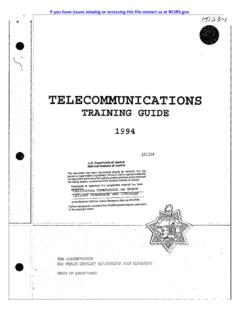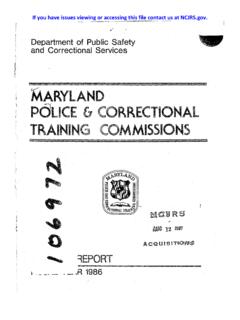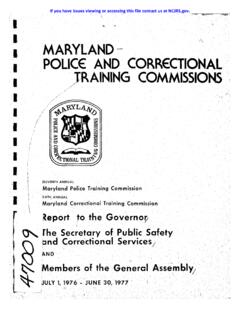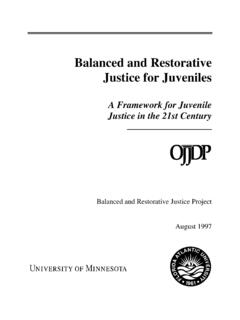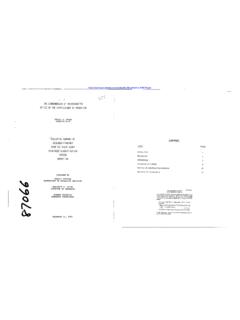Transcription of Robotics for Law Enforcement: Beyond Explosive Ordnance ...
1 1839 2000 Robotics for Law enforcement : Beyond Explosive Ordnance Disposal H. G. Nguyen J. P. Bott Approved for public release; distribution is unlimited. 03 03 0 03 T'" SSC San Diego If you have issues viewing or accessing this file, please contact us at | i i i ! ! l I I I l I I I I ! I ! ! I I I ! I I I I I i I I I I i I I I /%~4# TECHNICAL REPORT 1839 November 2000 Robotics for Law enforcement : Beyond Explosive Ordnance Disposal H. G. Nguyen J. R Bott PROPERTY OF National Criminal Justice Reference Service (NCJRS) Box 6000 r4ocKv lie, MD 20849-6000 Approved for public release; distribution is unlimited. @ SPA WAR Systems Center San D/ego SSC San Diego San Diego, CA 92152-5001 1 SSC SAN DIEGO San Diego, California 92152-5001 I i I Ernest L.
2 Valdes, CAPT, USN Commanding Officer R. C. Kolb Executive Director ADMINISTRATIVE INFORMATION The work described in this report was performed for the National Institute of Justice's Office of Science and Technology by the SSC San Diego Adaptive Systems Branch (D371). Released by R. T. Laird, Head Adaptive Systems Branch Under authority of C. D. Metz, Head Advanced Systems Division DISCLAIMER With respect to information provided in this document, neither the United States Government nor any of its employees make any warranty, expressed or implied, including but not limited to the war- ranties of merchantability and fitness for a particular purpose. Further, neither the United States Gov- ernment nor any of its employees assume any legal liability for the accuracy, completeness, or useful- ness of any information, apparatus, product or process disclosed.
3 Reference herein to any specific commercial products, processes, or services by trade name, trademark, manufacturer, or otherwise does not necessarily constitute or imply its endorsement or recommendation of the United States SB ! | ! i | I I I ! l g g i a a I I I I i ,I i I I I I I I I I I I I I EXECUTIVE SUMMARY Mobile Robotics has matured quickly in the past decade, with more and more robots entering practical field service. The two most active application areas for mobile robots so far have been military and law enforcement . For law enforcement , most activities to date have been in the area of Explosive Ordnance disposal (EOD), where robots are used to keep the human bomb disposal expert out of harm's way.
4 In 1999, the National Institute of Justice (N/J) funded the Battelle Memorial Institute to perform a survey on the desired attributes of an EOD robot . In addition, NIJ funded the Space and Naval Warfare Systems Center, San Diego (SSC San Diego), to assess law- enforcement needs for robots Beyond EOD and identify technologies from Department of Defense (DoD) Robotics projects that can help meet those needs. To establish law- enforcement needs for non-EOD robots, we conducted a web-based survey over a period of 8 weeks, hosted on our SSC San Diego Robotics web site. The survey addressed scenarios and tasks where a robot would be used if available, and the tools, features, and parameters deemed most important to carry out those tasks.
5 It also solicited respondents' experiences with currently available robots. The survey was publicized by electronic mail to over 200 state and local law enforcement agencies. To identify DoD Robotics technologies that could contribute to the development of law- enforcement robots, we conducted face-to-face, telephone, and e-mail interviews with personnel from the Unmanned Ground Vehicles/Systems Joint Project Office (UGVS/JPO) and the Defense Advanced Research Projects Agency (DARPA). With leads from these funding and program- management agencies, we contacted various DoD Robotics research and development activities and their contractors. We presented results from the two surveys. In particular, we found that the law- enforcement community placed the most emphasis on having robots perform the functions of small-item delivery, passive remote communication, and remote surveillance.
6 Features of a robot that were viewed as most important include stair-climbing ability, a robust communication link, low cost, and longer battery life. Most of these requirements are being addressed by the DoD activities surveyed. Solutions for other requirements can be found in the commercial sector or are being sought by the scientific community for applications outside Robotics . We concluded that there would be no single robot that would meet all the demands of law enforcement Beyond EOD, and recommended the development of two classes of robots, separated by size. Each robot should be modular, with application-specific mission packages or tool sets that can be tailored to the needs of a specific user.
7 We also outlined a proven, user-centric, phased, rapid- prototyping approach for a successful Robotics development program. Finally, we recommended that NIJ personnel continue to maintain close liaison with DARPA and the Joint Robotics Program (JRP), and obtain input from JRP in the technology assessment, source selection, and development of Robotics assets. iii | | ,| [l H It CONTENTS 1. BACKGROUND .. 1 2. LAW- enforcement NEEDS .. 3 SURVEY PROCEDURE .. 3 SURVEY RESULTS .. 3 Specialties .. 4 Robotics Experience .. 5 Scenarios .. 5 Tasks .. 6 Tools .. 10 Features .. 11 Mobility .. 16 General Features .. 16 Past Experience .. 20 General Interests .. 20 DIFFERENTIATION BY Robotics EXPERIENCE.]
8 20 3. DEPARTMENT OF DEFENSE EFFORTS .. 23 JOINT Robotics PROGRAM (JRP) .. 23 UGV/S JPO .. 23 Man-Portable Robotic System (MPRS) .. 23 SPIKE .. 25 MATILDA .. 26 Other robot -Mounted Weapons and Tools .. 27 DEFENSE ADVANCED RESEARCH PROJECTS AGENCY (DARPA) .. 28 Tactical Mobile Robotics (TMR) .. 28 Distributed Robotics (DR) .. 30 Micro Unattended Mobility System (MUMS II) .. 30 4. CORRELATION BETWEEN LAW- enforcement NEEDS and DoD EFFORTS .. 31 5. RECOMMENDATION .. 33 6. REFERENCES .. 35 APPENDICES A: SURVEY QUESTIONNAIRE .. A-1 B: TABULATED RESULTS, ENTIRE DATA SET .. B-I C: TABULATED RESULTS, RESPONDENTS REPORTING PRIOR Robotics EXPERIENCE .. C-I D: TABULATED RESULTS, RESPONDENTS REPORTING NO Robotics EXPERIENCE.
9 D-1 Figures 1. Geographic orgin of survey responses .. 4 2. Specialties of respondents .. 4 3. Robotics experience among respondents .. 5 4. Frequency of robot use (if available) in various scenarios .. 6 5. Explosive breaching .. 7 6. Shattering windows .. 7 7. Opening doors .. 7 8. Observation/visual surveillance .. 8 9. Listening/audio surveillance .. 8 10. Delivery of small items .. 8 11. Passive remote communication (by speaker and microphone) .. 9 12. Delivering chemical agents .. 9 13. Retrieving small objects .. 9 14, robot -mounted weapons .. 10 15. Video cameras .. 10 16. Other sensors and effectors .. 11 17. Maximum and most useful speeds .. 11 18. Most appropriate weight .. 12 19.
10 Most appropriate size .. 12 20. Maximum reach .. 13 21. Operating/stand-off distance .. 13 22. Mission duration .. 13 23. Manipulator lift capability .. 14 24. Reasonable procurement cost .. 14 25. Reasonable initial training time .. 15 26. Reasonable maintenance time per month .. 15 27. Reasonable annual maintenance cost. excluding in-house labor .. 15 28. Importance of being able to traverse various outdoor terrain .. 16 29. Importance of being able to traverse various indoor terrain features .. 17 30. Importance of various communication links .. 17 31. Importance of various video interfaces .. 18 32. Importance of various self-defense mechanisms .. 18 33. Importance of various advanced features.
